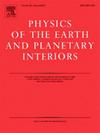Constraining the parameters of the Andrade rheology in Earth's mantle with Love numbers of 12 tidal constituents
IF 1.9
3区 地球科学
Q2 GEOCHEMISTRY & GEOPHYSICS
引用次数: 0
Abstract
We use estimates of Earth's tidal response at 12 frequencies (M2, Mqm, Msqm, Mtm, Mstm, SN, Mf, Msf, Mm, Msm, Ssa, Sa) to constrain the values of the Andrade parameters in Earth's mantle. The viscoelasticity and anelasticity of the planet are modeled using the Andrade rheology which depends on the frequency of the tidal forcing, the viscosity profile of Earth's interior, and two parameters ( and that are unknown for planetary interiors. We compute Earth's tidal deformation and its Love numbers for the 12 mentioned frequencies, for 3 viscosity profiles, and for a total of 2850 different combinations of values of and in the ranges and .
By comparing the computed complex Love numbers k2, h2 and l2 at each tidal frequency with their available estimates, we obtained the values of the Andrade parameters and that successfully reproduce Earth's observed anelastic behavior. Our best estimates for these parameters in Earth's interior are and . However, values within the broader ranges of and may also be suitable, with the majority of the variability stemming from uncertainties in Earth's viscosity profile. Not all combinations of and within these ranges are acceptable and every value of has its own appropriate range of values closer to the upper bound 0.256 are only suitable if 0.2, while values closer to the lower bound 0.2 must be accompanied by 3.
Here we emphasize the importance of using an Andrade rheology with two free parameters when modeling planetary interiors, instead of the common practice of always setting . Depending on the used viscosity profile, may not adequately explain the observed anelasticity of the Earth within the explored tidal frequency range.
用12个潮汐组分的Love数约束地幔的Andrade流变参数
我们使用12个频率(M2, Mqm, Msqm, Mtm, Mstm, SN, Mf, Msf, Mm, Msm, Ssa, Sa)的地球潮汐响应估计来约束地幔中Andrade参数的值。行星的粘弹性和非弹性是用安德拉德流变学建模的,这取决于潮汐强迫的频率,地球内部的粘度分布,以及行星内部未知的两个参数(α和ζ)。我们计算了12个提到的频率,3个粘度剖面,以及在α∈0.13,0.37和ζ∈10−2105范围内α和ζ值的总共2850种不同组合的地球潮汐变形及其Love数。通过将计算得到的在每个潮汐频率下的复数Love数k2、h2和l2与现有的估计值进行比较,我们得到了Andrade参数α和ζ的值,它们成功地再现了地球观测到的非弹性行为。我们对地球内部这些参数的最佳估计是α∈0.2180.238,ζ∈0.5133。然而,α∈0.2000.256和ζ∈0.2485的范围内的值也可能是合适的,其中大部分的变率源于地球粘度剖面的不确定性。在这些范围内,并非所有α和ζ的组合都是可以接受的,α的每个值都有自己合适的ζ范围:接近上界0.256的α值只适用于0.2<ζ<20,而接近下界0.2的α值必须伴随着3<;ζ<485。在这里,我们强调使用Andrade流变学与两个自由参数建模行星内部的重要性,而不是通常的做法总是设置ζ=1。根据所使用的粘度剖面,ζ=1可能不能充分解释观测到的地球在勘探潮汐频率范围内的非弹性。
本文章由计算机程序翻译,如有差异,请以英文原文为准。
求助全文
约1分钟内获得全文
求助全文
来源期刊

Physics of the Earth and Planetary Interiors
地学天文-地球化学与地球物理
CiteScore
5.00
自引率
4.30%
发文量
78
审稿时长
18.5 weeks
期刊介绍:
Launched in 1968 to fill the need for an international journal in the field of planetary physics, geodesy and geophysics, Physics of the Earth and Planetary Interiors has now grown to become important reading matter for all geophysicists. It is the only journal to be entirely devoted to the physical and chemical processes of planetary interiors.
Original research papers, review articles, short communications and book reviews are all published on a regular basis; and from time to time special issues of the journal are devoted to the publication of the proceedings of symposia and congresses which the editors feel will be of particular interest to the reader.
 求助内容:
求助内容: 应助结果提醒方式:
应助结果提醒方式:


